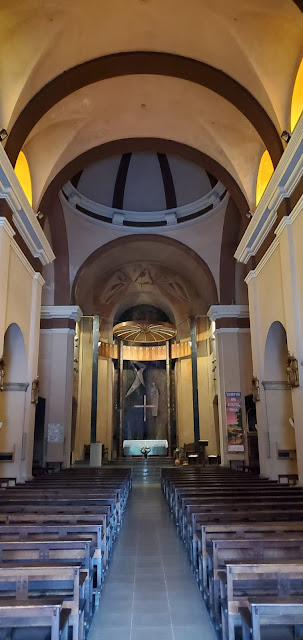Sally and Beth host inSPIREd Sunday!
May 2019 - Barcelona Spain
May 24 Barcelona
The Church of The Virgin of Gràcia and St. Joseph sits at the northern end of the former village of Gràcia, a municipality now well-within Barcelona’s city limits. Located on the north side of the Plaça de Lesseps, the building was originally the convent church of a community of Descalced Carmelites of St. Joseph – hence the parish’s nickname as the home of “els Josepets”. The community was so well-known that, until renamed for 19th century Barcelona politician Ferdinand de Lesseps, the site on which it sits was also colloquially referred to as Josepets Square.
Originally the Carmelites had a rather large monastic complex downtown on the Ramblas, the Monastery of St. Joseph (1586-1835), which was later torn down to make way for the Boqueria Market. In the 17th century, the place was bursting at the seams, in part because of the vocational influence of the two great Spanish Carmelite reformers, Sts. Teresa of Avila and John of the Cross. The monks approached local magnate Josep Dalmau about obtaining an auxilliary site for the community, and Dalmau donated this site in the village of Gràcia, then some distance outside of the city.
The new monastery was formally founded in 1626. In 1628 the cornerstone of the original complex was laid, and by 1630 the first monks were able to move in; the first church on the site was finished by 1634. By 1647 the complex was largely complete, and the novices from the St. Joseph Convent on the Ramblas were sent up to study in their new digs in Gràcia. In 1650-51 an epidemic of plague struck the neighborhood, killing off many of the brothers. The surviving monks were taken back to the original convent and the site was abandoned for several years.
The present building, which is in a late Renaissance/Mannerist style, was begun in 1658 when the monks returned, and was completed in 1687.
During the 19th century anti-clericism reared its ugly head in Spain numerous times, and many religious communities were turned out of their monasteries; the Josepets were no exception. Because of the Napoleonic wars, the Josepets were forced to abandon the monastery between 1808 and 1814. After they returned, a new wave of plague broke out in 1821, causing the monks to go back to the Ramblas convent until 1823. Subsequently a new period of religious persecution by the Left arose, and the Josepets were finally thrown out for good in 1835. The complex was then auctioned off to the public in 1837, most of the buildings were torn down, and the rest fell into disrepair.
In 1868, following decades of complaining by locals about the need for an additional church in the north end of Gràcia, the former monastic chapel became the center of a new parish for the neighborhood, and was restored. Unfortunately, this was not the end of the building’s troubles. As occurred in many places in Barcelona, the church was sacked and burned by the Leftists in 1936. The parish re-formed in 1939 and held masses nearby until the church could be restored, and masses resumed just before Christmas in 1940.














your dedication to research and detail amazes me, and you do it so often. what a legacy you will one day leave.
ReplyDeleteit's a pretty church.
Thanks, Andrew. It's the business analyst in me from my former life, I think.
Delete...they sure build beautiful churches in Europe.
ReplyDeleteBeautiful church and well researched history, Just one thing puzzleing me you refered to monks living in a convent at one point, I thought that was where nun's lived and monks in a abbey or monistary
ReplyDeleteBilly, you got me curious about this too. So I did what one does, and googled "convent".
DeleteWikipedia informed me that:
A convent is either a community of priests, religious brothers, religious sisters, monks or nuns; or the building used by the community, particularly in the Catholic Church, Lutheran Churches, and the Anglican Communion.
A lovely church!
ReplyDelete